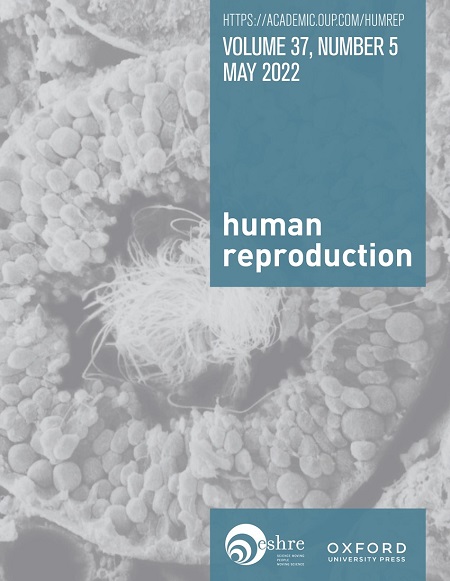Reduced live birth rates following ART in adenomyosis patients: a matched control study
IF 6
1区 医学
Q1 OBSTETRICS & GYNECOLOGY
引用次数: 0
Abstract
STUDY QUESTION How does adenomyosis affect live birth rates (LBRs) in women undergoing ART compared to a matched control population? SUMMARY ANSWER Women with adenomyosis, matched with controls for age, blastocyst count, and top-quality blastocyst count, exhibited reduced LBR following IVF/ICSI treatment. WHAT IS KNOWN ALREADY Adenomyosis, a benign uterine disorder, is believed to hinder implantation due to anatomical, hormonal, and immune disruptions. Its precise impact on LBRs following ART, however, remains controversial, with studies presenting inconsistent outcomes. It is uncertain whether adenomyosis directly reduces ART success or if confounding factors such as age or embryo quality play a more significant role. STUDY DESIGN, SIZE, DURATION This observational study included women aged 18–42 years undergoing IVF/ICSI treatments with a freeze-all strategy from 1 January 2018 to 31 December 2022, each having at least one available blastocyst for transfer. The adenomyosis group consisted of patients with a confirmed diagnosis through pelvic MRI, interpreted by gynecologic radiologists. The control group included women without adenomyosis, who had idiopathic, tubal, and/or male factor infertility. PARTICIPANTS/MATERIALS, SETTING, METHODS A total of 285 women with adenomyosis were included. These patients were matched 1:1 with controls based on age, the number of cryopreserved blastocysts, and the number of top-quality blastocysts. The primary outcome was the cumulative LBR per patient following a single oocyte retrieval, with secondary outcomes including clinical pregnancy rate (CPR) and early miscarriage rate (EMR). Both univariate and multivariate analyses were conducted. MAIN RESULTS AND THE ROLE OF CHANCE In this study, 285 women with adenomyosis were matched with 285 controls. The mean age was 35.4 ± 3.3 and 35.5 ± 3.4 years, respectively, with an average of 3.5 ± 2.5 and 3.6 ± 2.6 cryopreserved blastocysts and 0.4 ± 0.7 and 0.4 ± 0.5 top-quality blastocysts, respectively. In the adenomyosis group, MRI revealed internal diffuse adenomyosis in 73.7% of patients, adenomyoma in 3.5%, and external adenomyosis lesions in 46.7%. The cumulative LBR was significantly lower in the adenomyosis group compared to controls (41.4% versus 51.9%; odds ratio = 0.65, 95% CI [0.47–0.91]; P = 0.012). Similarly, the CPR was reduced in the adenomyosis group (53.3% versus 63.9%; P = 0.011). No significant difference was found in the EMR. Multivariate analysis, adjusted for confounders such as freeze-all indication, AMH levels, BMI, infertility type, and ART procedure (IVF versus ICSI), identified adenomyosis as an independent risk factor for reduced LBR (OR = 0.7, 95% CI [0.4–0.9]). These findings indicate that adenomyosis is associated with lower ART success rates. LIMITATIONS, REASONS FOR CAUTION Patients included in this study were from a specialized referral center focusing on the management of endometriosis and adenomyosis, potentially introducing selection bias, as these women may have more severe forms of adenomyosis. WIDER IMPLICATIONS OF THE FINDINGS For infertile women, it is crucial for practitioners to conduct comprehensive clinical and imaging assessments to detect adenomyosis. Continued research is needed to refine and personalize ART management strategies for patients affected by this condition. STUDY FUNDING/COMPETING INTEREST(S) No external funding was received. P.V. is the co-editor-in-chief of the Journal of Endometriosis and Uterine Disorders. C.M. has received payments to her institution from Merck, Ferring, Theramex, Gedeon Richer, and Besins, as well as direct payments to her from Gedeon Richter and Ferring and honoraria from Merck Serono, Ferring, Besins, IBSA, and Organon and meeting/travel support but no payment from Ferring, Besins, and Gedeon Richter. C.C. has received grants from Merck, Ferring, Theramex, Gedeon Richter, and Besins, which were paid to his institution, and honoraria from Merck, Besins, Gedeon Richter, and Theramex, which he received directly. He has also received support for attending meetings from Besins, Gedeon Richter, and Merck but no payment. He is a founder and past-president of the Society for Endometriosis and Uterine Disorders (SEUD), an unpaid role. P.S. received grants or contracts from Merck, Ferring, Theramex, Gedeon Richter, Besins, paid to his institution, and direct payment to him for presentations and lectures from Merck, Ferring, Besins, Gedeon Richter, Theramex, IBSA, and General Electric Medical Systems. He also received travel support but no payment from Merck, Ferring, Besins, Gedeon Richter, Theramex, and IBSA. P.S. is a board member of the SEUD and an editorial board member of RBMO and GOF. C.P. has received payment for lectures and presentations from Ferring and support but no payment for attending meetings from Ferring. M.B. has received grants from Merck, Ferring, Theramex, Gedeon Richter, and Besins, which were paid to her institution, and direct payment from Merck, Ferring, Gedeon Richter, Theramex, IBSA, and Organon for lectures/presentations. She has also received support but not payment for attending meetings from Ferring and Gedeon Richter. TRIAL REGISTRATION NUMBER Not applicable.降低子宫腺肌症患者ART后的活产率:一项匹配对照研究
获得了Merck、Ferring、Theramex、Gedeon Richter和Besins的资助,这些资助都支付给了她所在的机构,并直接获得了Merck、Ferring、Gedeon Richter、Theramex、IBSA和Organon的讲座/演讲费用。她也得到了Ferring和Gedeon Richter的支持,但没有为参加会议支付费用。试验注册号不适用。
本文章由计算机程序翻译,如有差异,请以英文原文为准。
求助全文
约1分钟内获得全文
求助全文
来源期刊

Human reproduction
医学-妇产科学
CiteScore
10.90
自引率
6.60%
发文量
1369
审稿时长
1 months
期刊介绍:
Human Reproduction features full-length, peer-reviewed papers reporting original research, concise clinical case reports, as well as opinions and debates on topical issues.
Papers published cover the clinical science and medical aspects of reproductive physiology, pathology and endocrinology; including andrology, gonad function, gametogenesis, fertilization, embryo development, implantation, early pregnancy, genetics, genetic diagnosis, oncology, infectious disease, surgery, contraception, infertility treatment, psychology, ethics and social issues.
 求助内容:
求助内容: 应助结果提醒方式:
应助结果提醒方式:


